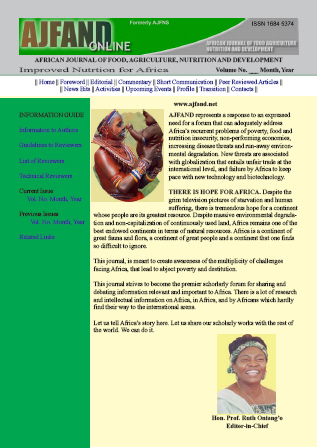
|
African Journal of Food, Agriculture, Nutrition and Development
Rural Outreach Program
ISSN: 1684-5358
EISSN: 1684-5358
Vol. 16, No. 4, 2016, pp. 11351-11366
|
 Bioline Code: nd16067
Bioline Code: nd16067
Full paper language: English
Document type: Research Article
Document available free of charge
|
|
|
African Journal of Food, Agriculture, Nutrition and Development, Vol. 16, No. 4, 2016, pp. 11351-11366
| en |
ELEMENTAL COMPOSITION AND POTENTIAL HEALTH IMPACTS OF Phaseolus vulgaris  L. ASH AND ITS FILTRATE USED FOR COOKING IN NORTHERN UGANDA L. ASH AND ITS FILTRATE USED FOR COOKING IN NORTHERN UGANDA
Bergeson, TL; Opio, C & Arocena, JM
Abstract
Ash from burnt crop residue of common bean (Phaseolus vulgaris L.) is typically used to generate filtrate in rural Northern Uganda. The filtrate is added to hard-to-cook foods, like dried legumes, to decrease cooking time and improve flavor. However, the elemental composition of ash filtrate and health implications of its use is poorly understood. This study aimed to determine the elemental composition of Phaseolus vulgaris L. ash and its filtrate, to identify variation among study sites, and to assess the potential health impact of ash filtrate consumption in Northern Uganda. Dried ash and ash filtrate samples of P. vulgaris from Dog Abam, Telela, Arok, and Tit villages in Northern Uganda were analyzed for chemical composition. Ash filtrate samples were procured from ash according to local methods. Nutritional impact was assessed by comparing recommended daily intake (RDI) guidelines for Canada and Uganda. Potassium (K), sodium (Na), magnesium (Mg), manganese (Mn), and iron (Fe) concentration in dry crop ash samples varied significantly among study sites. Ash filtrate contained lower concentrations of all elements, suggesting considerable losses through filtration; but showed an alkaline pH (10.1 to 10.8). Elemental concentration present in probable daily intake of ash filtrate (approximately 15 milliliters/person) was within acceptable RDI ranges for elements of known dietary importance. The alkaline pH levels of the ash filtrate may have potential negative effect on diet by decreasing bioavailability of specific minerals (for example, Fe and Zn) and/or having destructive effects on various nutrients (for example thiamine). Further research should be conducted in Northern Uganda and other areas where ash filtrate is in use to determine the specific health effects of this cultural practice. Such studies could include, but not limited to, biological analysis, detailed nutritional studies, and/or long-term monitoring of filtrate consumers. The information gathered from such studies could be critical in formulating appropriate policies regarding the use of ash filtrate.
Keywords
Food composition; nutrients; Phaseolus vulgaris L. ash filtrate; potential health problem; Uganda
|
| |
© Copyright 2016 - African Journal of Food, Agriculture, Nutrition and Development
Alternative site location: http://www.ajfand.net/
|
|
